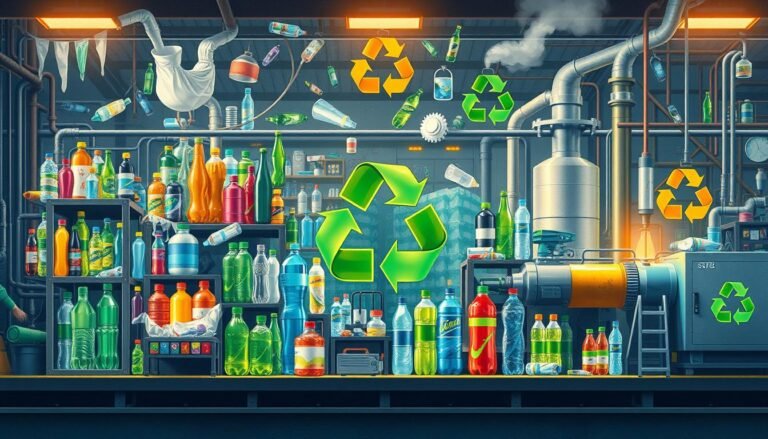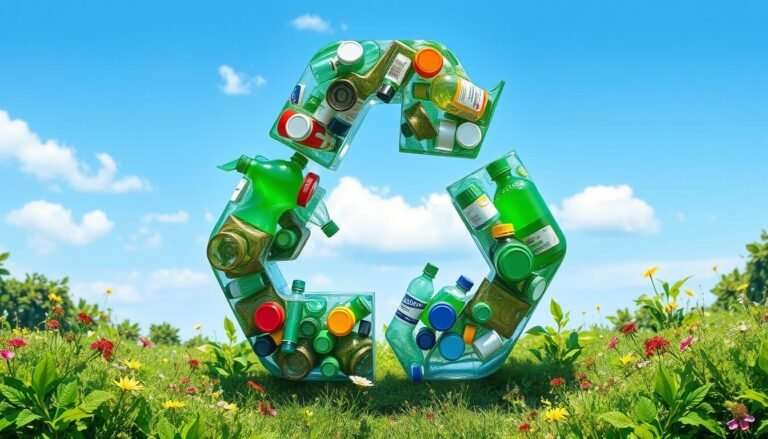Make some changes to the world environment
-
Building 3, Wanyang Innovation City, Langxia Street, Yuyao City, Zhejiang Province
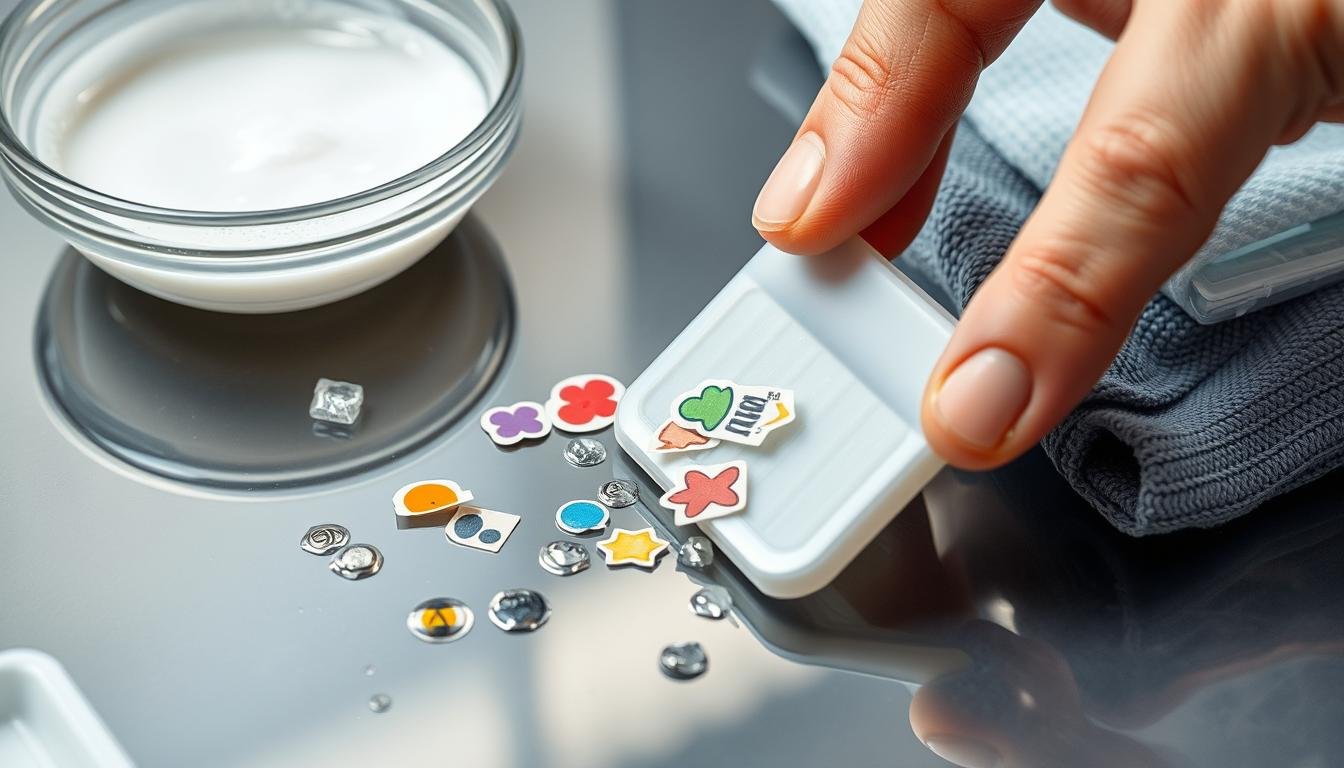
Efficient Guide: Remove Stickers from Plastic
Ever struggled with getting stickers off plastic? You try and try, but that sticky mess won’t go away. This guide will show you how to get rid of them for good. It’s detailed and full of tips to help you.
Want a secret weapon from your kitchen? Warm soapy water can be a game-changer1. We’ll show you how to use simple things like vinegar and vegetable oil. Even things like Goo Gone can make the job easy and quick1.
We’re here to make removing sticker gunk easy. Follow our tips, and you can keep your plastic looking new. Ready to find out how to do it smoothly? Check out our guide for all the details.
Key Takeaways
- Soaking plastic items in warm soapy water softens stickers for removal.
- Common household items like vinegar and vegetable oil can effectively remove adhesive residues.
- Advanced techniques such as applying heat from a hairdryer can aid in sticker removal from plastic2.
- Commercial adhesive removers like Goo Gone work effectively on various surfaces to dissolve adhesives1.
- Post-removal care is crucial to maintaining the quality of plastic surfaces.
Introduction to Sticker Removal from Plastic
Getting stickers off plastic can be tough because of the glue and the plastic’s smoothness. It’s important to remove stickers carefully to avoid damaging the plastic or leaving sticky stuff behind. We’ll share the best ways to take stickers off plastic easily.
Before you start, know what tools and steps you’ll need. First, clean the area with warm soapy water. This helps loosen the sticker glue. It’s a simple step but very important for getting ready to remove the sticker more easily.
To prepare, gather some helpful items. You’ll need things like rubbing alcohol, white vinegar, dish soap, baking soda, and different oils (like vegetable oil or baby oil). These items help dissolve the glue on the plastic. Always test your cleaning solution on a small part of the plastic first. This prevents damage3.
If a sticker won’t come off easily, try heat and gentle scraping. Use plastic scrapers or old credit cards, which won’t scratch the plastic. Mixing these tools with the cleaning solutions mentioned earlier helps remove the sticker without hurting the plastic3.
Some things around the house can also help get stickers off. Vinegar and cooking oils are good examples. They weaken the sticker glue so it’s easier to clean off. These common items are safe and effective solutions3.
Knowing how to remove stickers from plastic means understanding both the physical and chemical approaches. This makes sure you clean up well and keep the plastic in good shape.
“Testing any cleaning solution on a small area before the full application prevents potential damage to the item.”
We’ve talked about using rubbing alcohol, white vinegar, dish soap, warm water, baking soda, cooking oil, and nail polish remover. The main point is to use these methods together. This way, the plastic stays nice while getting rid of any glue left behind3.
Why Stickers Are Difficult to Remove from Plastic
Trying to get stickers off plastic is tough. The sticker glue and plastic’s smoothness make a strong bond. This connection creates a difficult task for anyone wanting to remove stickers cleanly.
The Nature of Adhesives
Sticker glue is made to stick well to surfaces, especially on smooth, non-porous plastic. The glue and plastic interact tightly. This makes the sticker hard to peel off. Some glues even get stronger with time, making the job harder45.
The Smoothness of Plastic Surfaces
Plastic’s smoothness is a big reason why stickers are hard to remove. Since plastic is not porous, it’s hard for air or cleaners to get under the sticker. This makes scraping or peeling methods less effective. Using chemicals or heat to loosen the glue is often better but must be done carefully to avoid damaging the plastic56.
Knowing about the glue and plastic helps find the best way to remove stickers without harm.
How to Remove Stickers from Plastic: Step-by-Step Guide
Getting stickers off plastic can feel hard. But, if you follow a step-by-step guide, you can keep the plastic looking new. Our guide offers handy tips and detailed steps for removing stickers without harming the surface.
Gathering Your Supplies
First, get everything you’ll need ready. You should have plastic scrapers, warm soapy water, rubbing alcohol, and a soft cloth. These tools help with each step, from cleaning to scraping, and protect the plastic.
Initial Cleaning with Warm Soapy Water
Begin by washing the plastic with warm soapy water. This step loosens the sticker’s glue and gets the surface ready for the next steps. Warm, soapy water works well for peeling off tough stickers from different items. It’s a good first step for sticker removal7.
Also, soap and water can handle various adhesives without damaging the surface.
Scraping Off the Sticker
After cleaning, gently use a plastic scraper to lift the sticker’s edges. Be careful to avoid scratches. If there’s still glue left, try rubbing alcohol or Goo Gone, but follow the product’s directions. Make sure the room is well-aired8. This helps to get rid of any remaining glue for a cleaner surface.
To learn more about keeping things green, check out PP plastic recycling for eco-friendly tips.
Effective Methods for Removing Stickers from Plastic
Looking for the best ways to take stickers off plastic? We’ve found a few top methods. Rubbing alcohol works wonders by breaking down the sticky stuff. Just apply it and wait for five minutes9. WD-40 is another great choice. Spray it on, wait for three minutes, then rub off the residue9.
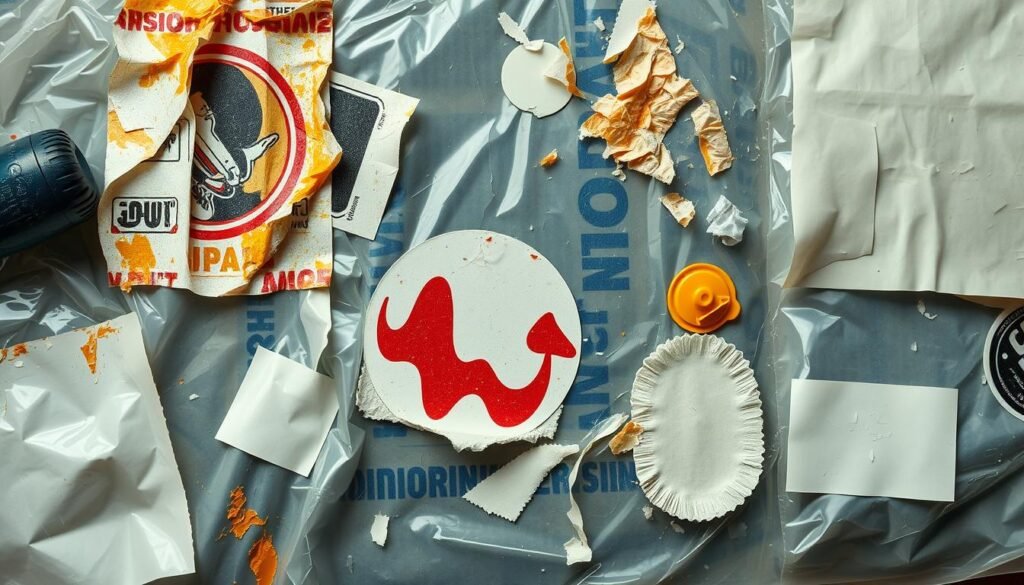
Seeking a greener option? Try white vinegar. Soak a towel in vinegar, place it on the sticky area, and wait a few minutes9. If you’re okay with chemicals, Goo Gone is strong against stickers. Leave it for up to three minutes, then clean the area9.
Using heat can also make the process easier. A hair dryer can loosen the adhesive in just 30 seconds9. Together with warm vegetable oil, this method can make removing stickers easier2.
Another handy trick involves warm soapy water. Soak the item for 15 minutes to soften the sticker and residue9. Or use olive oil; it’s great for getting rid of the sticky mess with a simple wipe9.
Need precision? A razor blade or an X-Acto® knife works well for careful sticker removal. This ensures the plastic stays scratch-free5. Using these tips, you can keep your plastic items looking new and clean.
Utilizing Household Items for Sticker Removal
Household items can be effective for removing stickers naturally. Vinegar, vegetable oil, and even peanut butter can make the process easier. You won’t have to use harsh chemicals.
Using Vinegar
Vinegar is great for getting rid of stickers due to its acid. Just put vinegar on the sticker, wait a bit, and the adhesive softens. It’s then easy to remove10. Plus, it’s cheap and doesn’t harm the planet11.
Using Vegetable Oil
Vegetable oil can also weaken sticker residue. Apply it on the sticker, wait a little, and then wipe or scrape the sticker away10. It’s safe to use on many types of surfaces like wood and glass10.
Peanut Butter Hack
Using peanut butter might seem strange, but it works well. Cover the sticker with a lot of peanut butter, wait, and wipe it off10. The oils in peanut butter dissolve the adhesive, making it easy to clean up11.
These natural methods for sticker removal can simplify your cleaning. By using these household remedies, you’ll save money and avoid chemicals in commercial products.
Advanced Techniques for Stubborn Stickers
When you find tough stickers on plastic, using advanced methods helps a lot. Applying heat, like from a blow dryer, makes the glue softer and easier to peel off12. This is really handy for stick-ons that don’t want to come off easily without ripping or leaving sticky stuff behind12.
Products like Goo Gone Spray Gel are also great for getting rid of hard-to-remove labels. Goo Gone works well to loosen the adhesive, making the job smoother13. For the best results, use heat and these removers together to get rid of even the toughest adhesives.
Having the right tools is important for these advanced sticker removal methods. Plastic putty knives or credit cards are good for scraping stickers without damaging the plastic. Pairing these tools with gentle heat helps avoid harm during the process1213.
Other smart ways to remove sticker glue include using a mix of warm water and dish soap. Soak a paper towel in it to dissolve the glue without damaging the plastic12. You can also use duct tape to pull off leftover adhesive bits. Rubbing alcohol or mineral oil can help remove stubborn glue residues12.
It’s important to be careful with these advanced techniques. Make sure not to harm the plastic with too much heat, especially with thin plastic like plastic windows13. Keeping your work area clean and using lint-free cloths for cleaning up will give you better results and protect the surfaces.
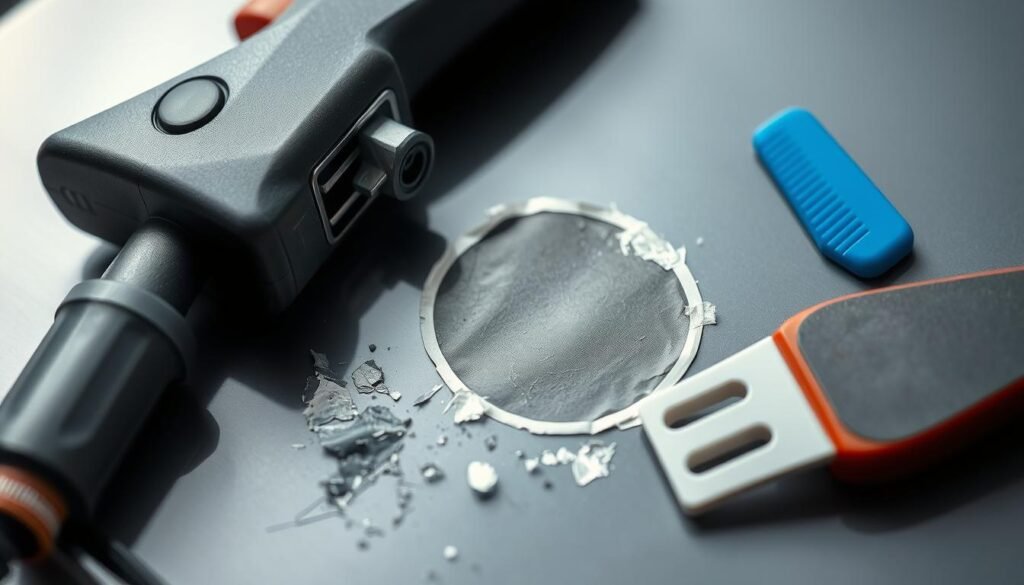
For businesses, using a machine like a Conical Twin Screw Extruder Granulator makes sticker removal from recyclable materials easier. This machine is great for plastic processing and is energy efficient. It supports precise granulation and recycling for resource recycling and sustainable development12.
By following these tips and sticking to best practices, removing stubborn stickers becomes much easier. This keeps plastic surfaces looking good and intact.
Best Practices for Plastic Surface Sticker Removal
Keeping plastic looking good when taking off stickers is all about using the right methods. It’s important to follow certain steps to get rid of stickers without hurting the plastic’s look or strength.
Avoiding Scratches
A big worry when removing stickers from plastic is not scratching it. It’s key to use gentle ways and the right tools, like:
- Opt for a plastic scraper or your fingernail to ease the sticker off gently.
- Warm up the adhesive with a hair dryer to make peeling off the sticker easy, avoiding sharp tools5.
- If needed, a razor blade or X-Acto® knife can be carefully used for precise removal but be cautious to prevent scratches5.
Post-Removal Cleaning Tips
Once you’ve removed the sticker, it’s crucial to clean the area well. This helps ensure no sticky residue is left behind, keeping the plastic in top shape. Here are some tips:
- A cloth dipped in rubbing alcohol or nail polish remover can remove leftover adhesive6. Be careful with nail polish remover that contains acetone as it can harm plastic6.
- Applying household items like peanut butter or vegetable oil helps tackle sticky residue. Just let it sit before gently wiping it away with a soft cloth6.
- For tough glue spots, mix vegetable oil and baking soda to make a DIY Goo Gone. It’s a safe and effective way to clean6.
Using these sticker removal practices will keep your plastic looking great and free from residue. Always do a spot test with any method to make sure it doesn’t harm the plastic.
Top Products to Aid in Sticker Removal from Plastic
Choosing the right sticker removal products is key. You want something that works well, is safe, and easy to use on plastic. There are a few top picks that really stand out.
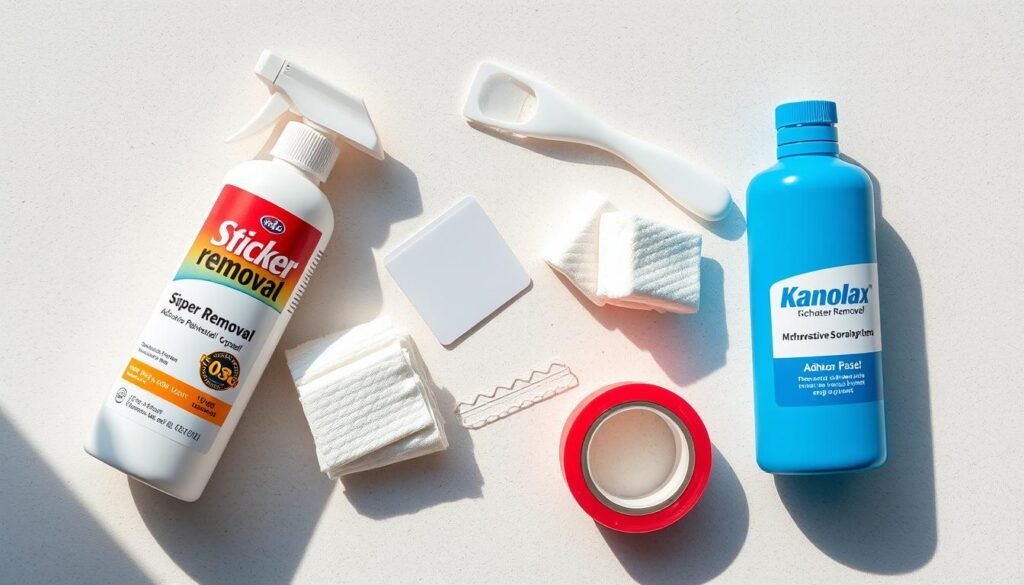
Goo Gone is a top choice because it works great on tough sticker glue. People love its nice orange smell for use around the house or at work14. WD40 is also great because it can do many things, especially removing sticky stuff from plastic14. And Turtle Wax Sticker Remover is made just for tough stickers5.
If you prefer natural solutions, isopropyl alcohol and white spirits are good picks. They get rid of glue without harming plastic14. Eucalyptus oil is another natural option that’s gentle on plastics14. Plus, white vinegar is a safe, eco-friendly choice5.
Be careful with acetone because it can damage plastic. Instead, try using mineral turpentine, methylated spirits, or nail polish remover. They’re safer for removing adhesive14.
We put together a table below to compare the best products. It shows their features and benefits:
| Product | Effectiveness | Ease of Use | Safety for Plastic | Special Features |
|---|---|---|---|---|
| Goo Gone | High | Easy | Safe | Pleasant Orange Scent |
| WD40 | High | Moderate | Safe | Multipurpose Use |
| Turtle Wax Sticker Remover | High | Easy | Safe | Formulated for Stickers |
| Isopropyl Alcohol | Moderate | Moderate | Safe | Natural Option |
| White Spirits | High | Moderate | Safe | Natural Option |
| Eucalyptus Oil | Moderate | Moderate | Safe | Natural Scent |
By picking good adhesive removers, taking stickers off plastic is easier and safer. You get a clean and satisfying finish14.
Troubleshooting Common Issues
Removing stickers from plastic can be tricky. One main problem is the sticky residue left behind. Another is getting rid of tough labels without harming the surface. We’ll show you how to deal with these issues safely and effectively.
Dealing with Persistent Residue
Sticky residue is a common hassle when taking off stickers. Household items can be real lifesavers here. Try soaking the area in a mix of vinegar and soap water for about 30 minutes to loosen the gunk15. Stay away from harsh chemicals like acetone that can damage the plastic15. Instead, try using gentle alternatives like cooking oil or peanut butter. These natural solutions safely remove the sticky stuff15.
Removing Stubborn Labels Without Damage
For those hard-to-remove labels, certain strategies work wonders. Using a hair dryer is one smart approach. Heat the label in short bursts, about 1 minute each, until it starts to peel away. This usually takes 3 to 5 minutes in total16. Or, letting labels soak overnight, for 6 to 8 hours, can ease removal16. These methods prevent damage to the plastic. Plus, using a product like Goo Gone can peel labels away quickly, often in just 15-30 minutes16.
Using Heat for Easier Sticker Removal
Heating up a sticker makes it much simpler to peel off. Controlled heat loosens the sticker’s glue, so it comes off clean. We’ll look at two heat methods to get stickers off: using a hair dryer and mixing hot water with dish soap.
Hair Dryer Method
The hair dryer method is super easy and keeps things clean. Aim the hot air at the sticker to soften the glue for easy removal17. It’s great because it doesn’t scratch or leave marks on plastic18. Plus, it’s fantastic for getting all the sticky residue off things like toys and household items17.
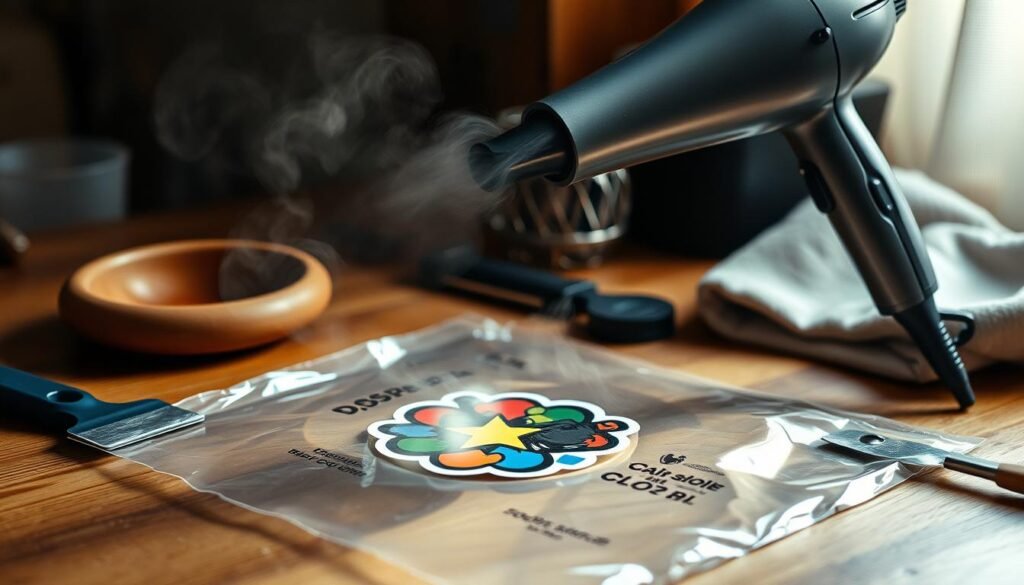
Hot Water and Dish Soap Technique
Using hot water and dish soap works well too. Soak the stickered spot in the hot soap mix to ease the sticker off19. This method is good for big areas and many plastic objects19. It’s not just for removing stickers. It also helps clean and care for the plastic18.
These heat methods make sticker removal much more efficient. They are perfect for business folks and manufacturers who deal with stickers often18. By using these techniques, we can tackle a frequent problem and keep plastic looking good.
Benefits of Using Natural Solvents
Using natural solvents for removing stickers is good for the planet and us. These solvents, like oils and vinegar, are eco-friendly ways to get rid of sticker glue. They are safe for the environment and for people using them. Plus, they’re easy to find at home and don’t cost much.
Natural solvents can get rid of glue without harming surfaces. For example, mixing vinegar with water works well to peel off stickers from things like laptops, cars, and windows. This method makes sure materials like HDPE can be recycled20. Also, it avoids the risks that come with harsh chemicals.
Natural solvents also help us recycle materials like HDPE. Recycling this kind of plastic reduces waste and helps the environment21. By using these solvents, we support recycling and take a step towards an eco-friendlier way to remove stickers.
Embracing the benefits of natural solvents in our everyday routines not only serves our immediate needs but also aligns with larger environmental objectives.
Using eco-friendly adhesives and methods reduces our environmental impact. MS (Microbial Solutions) suggests that warm white vinegar or soapy water works well in removing adhesives and is environmentally safe20. This shows the benefits of using natural methods, highlighting that they are safe and effective.
Adopting eco-friendly practices for sticker removal shows our commitment to sustainability and innovation. By choosing natural solvents, we get clean surfaces and help the environment. Every step towards being more eco-friendly makes a big difference for our planet.
Preserving the Plastic Surface After Sticker Removal
After taking stickers off, keeping the plastic surface looking good is key. We aim to keep plastic in top shape and offer the best care after sticker removal.
Cleaning and Polishing
First, clean the area with a mix of mild detergent and warm water. This step takes off any left-behind residues and gets the surface ready for polishing. If there’s tough residue, rubbing alcohol can help clean it well2223.
Then, make the plastic shine again with a good plastic polish and a soft cloth. Use gentle, circular motions. This approach helps keep the plastic looking great and scratch-free for a long time.
Restoring Any Damaged Areas
Sometimes, removing stickers might slightly damage the plastic. It’s important to fix these areas. A paste of baking soda and water can smooth out small scratches23. For bigger issues, products like Goo Gone or Citra Solv work well by dissolving any leftovers and helping in the repair23.
Also, vegetable oil is great for fixing the plastic after dealing with sticker residue23. Remember to do a final clean with mild detergent to remove any oil, making sure the surface is clear and smooth.
Using these cleaning and repairing techniques, we can give the best care after sticker removal. This way, we keep up with our commitment to excellent plastic preservation.
| Method | Tool/Ingredient | Purpose | Reference |
|---|---|---|---|
| Cleaning | Mild Detergent, Warm Water | Remove initial residues | 22 |
| Stubborn Residue | Rubbing Alcohol | Ensure clean surface | 2223 |
| Polishing | Plastic Polish, Soft Cloth | Restore shine | N/A |
| Minor Scratch Removal | Baking Soda Paste | Buff out scratches | 23 |
| Significant Restoration | Goo Gone, Citra Solv | Breakdown adhesives | 23 |
| Final Clean | Mild Detergent | Eliminate oily residues | N/A |
Conclusion
As we conclude this guide on sticker removal, let’s spotlight the key tips and tricks we’ve covered. We looked at how to remove stickers from surfaces like plastic, glass, metal, and wood. The right tools and strategies make this job a lot easier. Simple household items, such as vinegar, oils, and even peanut butter, have proven handy24. Plus, we’ve seen how applying heat or using products like WD-40 and Goof Off can help with those tough sticker residues24.
Remember, each type of surface needs its own special care to prevent damage. For example, mixing baking soda with vegetable oil works great on plastic. Metal surfaces can be cleaned with rubbing alcohol. And soapy water is safe for finished wood25. Trying out lemon juice, dish soap, or even an eraser can offer a custom fix for different sticky situations26.
Following these expert tips helps keep plastic items looking good after removing stickers. This guide gives you the knowledge and hands-on skills to remove adhesives without stress. With these strategies, keeping plastic surfaces clean and undamaged is easy, meeting our goal of top-notch results with smart, effective solutions.


